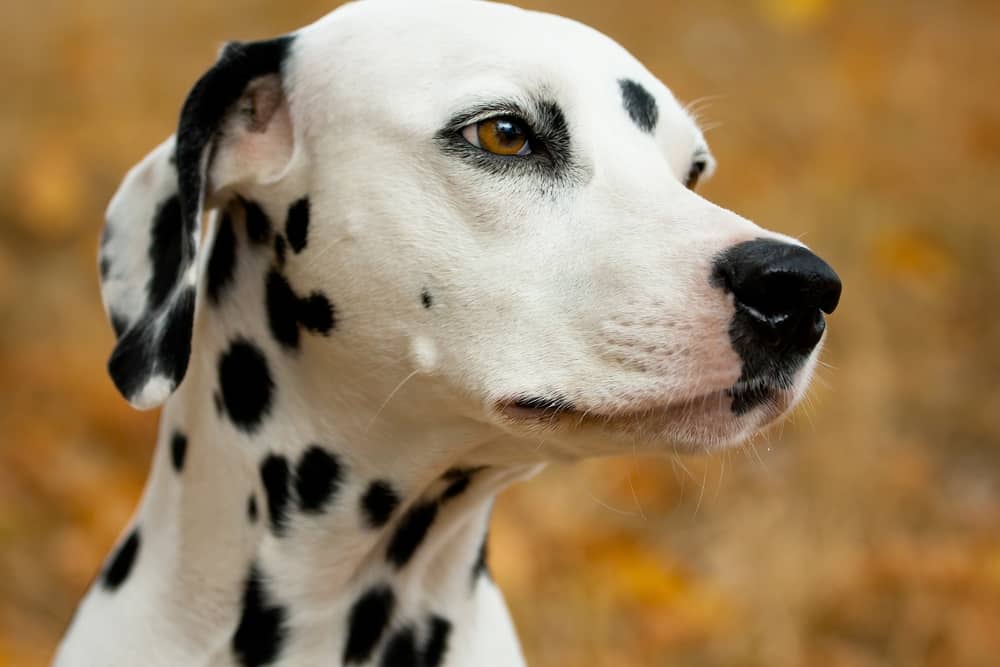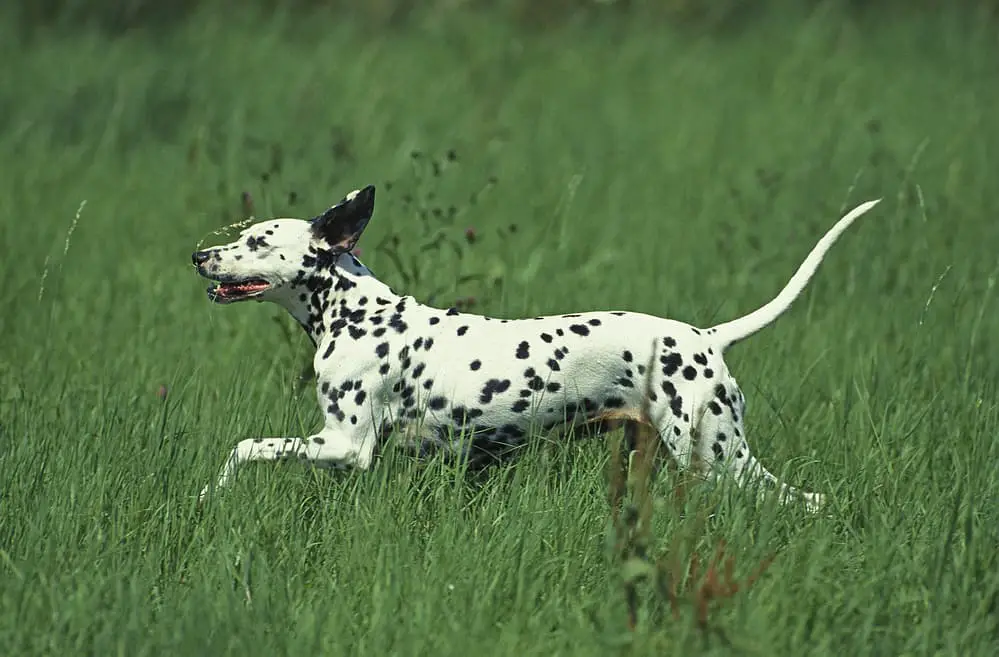Complete Guide To The Dalmatian: Health, Exercise, Feeding and More
Strong, athletic, and trustworthy, the Dalmatian is a standard for easily recognizable breeds. Between the stunning spotted coat and the trademark stance, the Dalmatian is a popular dog for families. This dog is extremely high energy but loving and loyal, making it a perfect dog for active and engaged families.
For me, a veterinarian with over 20 years of experience, I’m seeing this breed make a comeback. Earlier in my career this dog seemed to have so many issues that I couldn’t recommend it. However, a decrease in popularity has helped reputable breeders improve the genetic stock of the breed to a point where I can definitely recommend this breed once again.
Table of Contents
How Big Does A Dalmatian Get?
The Dalmatian is a large breed dog that stands 19 to 24 inches at the shoulder. Usually, these dogs will weigh between 45 and 70 pounds, with males being slightly larger than females. The dog is solid and muscular and is built to run and walk long distances with an effortless gait and efficient walking motion.

What Does A Dalmatian Look Like?
The most distinctive characteristic about the Dalmatian is the beautiful, unique spotted coat. The fur is short, silky, and extremely fine, almost like velvet on certain parts of the dog’s body. This dog has trademark spots, with a white base and well-defined black or liver-colored spots about the size of a dime to the size of a half-dollar. Spots cover the entire body and are usually smaller on the head, tail, and legs.
What Is The Personality Of A Dalmatian?
This breed of dog loves to be connected to their humans at all times and make fantastic companion dogs. They need to be close to their people, and if left alone for long periods, this dog can become anxious or destructive. The dog has a high energy level and is happy to accompany its favorite human for a jog, hike, or bike ride at a moment’s notice. For some, this dog is too high energy, and the constant need for activity can be exhausting.
Although intelligent, this dog may be challenging to train. The dog is extremely sensitive and does not respond well to negative reinforcement. Always use positive, upbeat training in short sessions. Use plenty of praise and treats to reward a job well done. Because this dog is so sensitive, it can remember harsh training methods or mistreatment, harboring resentment and mistrust for a lifetime.

How Much Grooming Does A Dalmatian Need?
While the Dalmatians may have short and sleek fur, they do shed a lot compared to other dogs. Be sure to keep up on regular brushing to help minimize the amount of shedding. Once per week, brush your dog with a slicker brush or short-bristle comb.
A bath every few months should be enough to keep your Dalmatian looking its best. Clean and check the ears once per month to remove dirt and debris, and be sure to keep the nails trimmed short if they are not naturally worn short by exercising on rough pavement.
How Much Exercise Does A Dalmatian Need?
This large, strong, and athletic dog is extremely high energy and needs plenty of exercise to keep it happy. This breed of dog is perfect for runners who are looking for a four-legged running partner. The Dalmatian was bred to run alongside carriages for great distances, so this dog has never-ending endurance that can be tough to match. If you cannot take a long, daily hike, be sure to participate in plenty of play sessions like fetch and tug-of-war.
The dog is athletic and performs well at canine athletic competitions. Enrolling your Dalmatian in flyball or canine agility contests is the perfect way to keep your dog exercised mentally and physically. Not only will your dog enjoy having an outlet for its endless energy, but you will get to enjoy some fun bonding time learning new activities with your dog.
What Kind of Dog Food Is Good For A Dalmatian?
Personally I believe that most foods are fine for most dogs. Some dogs may not do well on some foods. However, as a rule I don’t blanket-prohibit any dietary ingredient from any breed at this time.
Dalmatians that have liver or kidney disease will require special diets. However, feeding these types of diets in an effort to “prevent” those disease from popping up in the first place isn’t effective and may actually harm your dog.
Best Puppy Food For Dalmatians:
Best Adult Food For Dalmatians:
Please don’t listen to the folks at the pet store trying to convince you to buy a grain-free diet for your dog. There’s zero science behind that and vets are actually seeing diseases now related to feeding grain-free foods.
It’s very important they remain at their optimal weight throughout their life. Have your vet go over with you exactly where to feel to know when your dog is too big.
How Long Does A Dalmatian Live?
11-13 years based on information from the AKC
What Health Problems Can Dalmatians Have?
Dalmatians have had a history of being associated with certain health issues. Thankfully, the incidence of those have decrased in recent years due to improved breeding practices involving widespread genetic testing.
That being said, those health conditions that you need to be aware of include:
- Copper Storage Disease
- Bladder/Kidney Stones
- Deafness
- Epilepsy
- Kidney Disease
For these reasons, this is a breed that I greatly recommend to get pet insurance. Check out my overview of pet insurance options here. I also recommend regular annual bloodwork done starting at one year of age to catch any potential liver or kidney disease as early as possible.
Where Can I Find Out More About The Dalmatian?
Where Can I Find a Dalmatian?
Dalmatians are a popular breed of dog and are readily available from reputable breeders around the world. Before choosing a puppy, be sure to thoroughly research the breeder and the breed to understand what goes into owning a Dalmatian. Make sure that your breeder is doing the recommended testing so that your puppy has the best genetics possible.
Breeder Listings from the Dalmatian Club of America
This dog is often adopted by owners not ready to commit to the heavy exercise commitment. As such, many dogs end up being surrendered. There are countless Dalmatian rescue groups available, such as the Willing Heart Dalmatian Rescue, Inc, Antelope Valley Dalmatian Rescue, and the Dal-Savers Dalmatian Rescue group who specialize in this breed.
Fun Facts About the Dalmatian
- The Dalmatian’s origins are unknown, but its roots of being a coaching dog are well-defined in England. This dog had the job of running in front of horses and carriages, creating a clear path. When the horses were resting, the dog was responsible for guarding the coach and horses. This instinct remains in the Dalmatian today, and the dog still has a fondness for horses.
- Compared to other dogs, the Dalmatian has a very unique urinary system. To avoid chronic urinary complications, be sure the Dalmatian has plenty of water at all times and is regularly allowed access to relieve himself.
- Dalmatian pups are born solid white, and their spots only start to appear as they age. Sometimes the spots are well-defined, but other times patches appear with sharply defined edges. These sports can be black or liver-colored.
- Although the origins of this dog are unknown, the Dalmatian was popular with nomadic people, sometimes called gypsies. The Romanies, or gypsies, lived on the eastern coast of the Adriatic Sea in modern-day Croatia.
